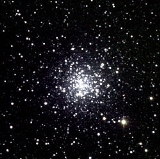
Messier 9
Encyclopedia
Messier 9 or M9 is a globular cluster
in the constellation
of Ophiuchus
. It was discovered by Charles Messier
in 1764.
M9 is one of the nearer globular clusters to the center of the Milky Way Galaxy with a distance of around 5,500 light-year
s. Its distance from Earth
is 25,800 light-years.
The total luminosity
of this cluster is around 120,000 times that of the Sun
, the absolute magnitude
being -8.04. The brightest individual star
s in M9 are of apparent magnitude
13.5, making them visible in moderately sized telescope
s. There have been 13 variable star
s found in M9.
Nearby, at about 80' to the northeast of M9 is the dimmer globular cluster NGC 6356, while at about 80' to the southeast is the globular NGC 6342.

Globular cluster
A globular cluster is a spherical collection of stars that orbits a galactic core as a satellite. Globular clusters are very tightly bound by gravity, which gives them their spherical shapes and relatively high stellar densities toward their centers. The name of this category of star cluster is...
in the constellation
Constellation
In modern astronomy, a constellation is an internationally defined area of the celestial sphere. These areas are grouped around asterisms, patterns formed by prominent stars within apparent proximity to one another on Earth's night sky....
of Ophiuchus
Ophiuchus
Ophiuchus is a large constellation located around the celestial equator. Its name is from the Greek "serpent-bearer", and it is commonly represented as a man grasping the snake that is represented by the constellation Serpens. Ophiuchus was one of the 48 constellations listed by the 2nd-century...
. It was discovered by Charles Messier
Charles Messier
Charles Messier was a French astronomer most notable for publishing an astronomical catalogue consisting of deep sky objects such as nebulae and star clusters that came to be known as the 110 "Messier objects"...
in 1764.
M9 is one of the nearer globular clusters to the center of the Milky Way Galaxy with a distance of around 5,500 light-year
Light-year
A light-year, also light year or lightyear is a unit of length, equal to just under 10 trillion kilometres...
s. Its distance from Earth
Earth
Earth is the third planet from the Sun, and the densest and fifth-largest of the eight planets in the Solar System. It is also the largest of the Solar System's four terrestrial planets...
is 25,800 light-years.
The total luminosity
Luminosity
Luminosity is a measurement of brightness.-In photometry and color imaging:In photometry, luminosity is sometimes incorrectly used to refer to luminance, which is the density of luminous intensity in a given direction. The SI unit for luminance is candela per square metre.The luminosity function...
of this cluster is around 120,000 times that of the Sun
Sun
The Sun is the star at the center of the Solar System. It is almost perfectly spherical and consists of hot plasma interwoven with magnetic fields...
, the absolute magnitude
Absolute magnitude
Absolute magnitude is the measure of a celestial object's intrinsic brightness. it is also the apparent magnitude a star would have if it were 32.6 light years away from Earth...
being -8.04. The brightest individual star
Star
A star is a massive, luminous sphere of plasma held together by gravity. At the end of its lifetime, a star can also contain a proportion of degenerate matter. The nearest star to Earth is the Sun, which is the source of most of the energy on Earth...
s in M9 are of apparent magnitude
Apparent magnitude
The apparent magnitude of a celestial body is a measure of its brightness as seen by an observer on Earth, adjusted to the value it would have in the absence of the atmosphere...
13.5, making them visible in moderately sized telescope
Telescope
A telescope is an instrument that aids in the observation of remote objects by collecting electromagnetic radiation . The first known practical telescopes were invented in the Netherlands at the beginning of the 1600s , using glass lenses...
s. There have been 13 variable star
Variable star
A star is classified as variable if its apparent magnitude as seen from Earth changes over time, whether the changes are due to variations in the star's actual luminosity, or to variations in the amount of the star's light that is blocked from reaching Earth...
s found in M9.
Nearby, at about 80' to the northeast of M9 is the dimmer globular cluster NGC 6356, while at about 80' to the southeast is the globular NGC 6342.


